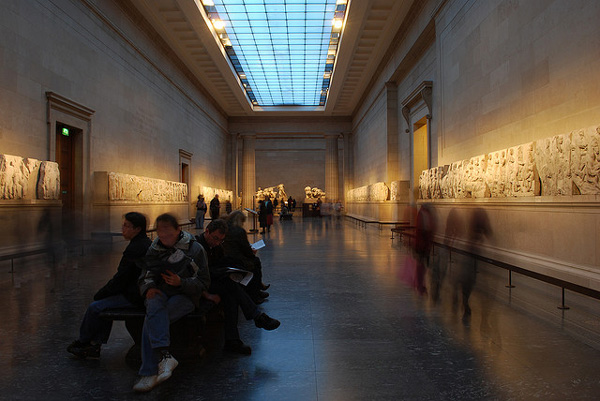October 13, 2014
Lawyers look at the Elgin Marbles, but stars keep them firmly in sight
By Marett Leiboff
Legal star power is being deployed in the form of the very well-known London barristers, Geoffrey Robertson QC and Amal Alamuddin, in Greece’s latest attempt to have the Elgin or Parthenon Marbles returned to Greece.

The Elgin Marbles at the British Museum. Photo: Stuartpilbrow via Flickr
Housed in the British Museum in London since 1816, these sculptures have been the subject of contentious legal to-ings and fro-ings since the early 1980s.
Under English law, the Museum owns the Marbles, and says it cannot lawfully return them to Greece. Greece contends they were removed unlawfully all those years ago and should be returned.
The dispute over the Marbles is one of the most high-profile, and fraught, of the many contested cultural objects and national treasures sitting in museums around the world.
Since the 1950s, waves of international laws or conventions have been passed to support the return of objects to their places of origin and, since the 1990s, more and more objects have been moved from museums back to their countries of origin.
People turn to lawyers to try to work out ways of either keeping the objects where they ended up, or to help them return them to their place of origin.
The complexity of the laws in this field means that lawyers are inevitably involved in these disputes, even if they are resolved without going to court.
Reports in various global media of their involvement suggest that Mr Robertson QC and Ms Alamuddin hold clear views on the return of the Marbles to Greece.
Mr Robertson is quoted from his book Crimes Against Humanity (2006) as arguing for the “return of cultural objects of great national significance”, while Ms Aladmuddin’s husband, American actor George Clooney, has publicly suggested that the Marbles be returned.
We are left in little doubt that these lawyers think these Marbles are culturally valuable. And there’s the rub.
Scrap metal or industrial history?
Even lawyers who have no interest in cultural claims know the Marbles matter. But other types of cultural objects – such as an old mousetrap machine – are not so easily “seen”. What lawyers “see” in front of them can make a difference to how cases might proceed.
This might seem straightforward enough. Some objects have labels on them that tell us they are important. Others don’t. In one court case, Re Pinion, many years ago, the judge was moved to call an art collection an “intolerable deal of rubbish”, based on the views of art experts.
It is clear that even if the experts had liked the art collection, the judge would still have found it “rubbish”.
But other cases are more complex and fall back on a longstanding legal problem about cultural objects: is the physical object itself what law should pay attention to, or is something else, such as its cultural value, important?
In Australia, there have been question marks over the cultural value of important military and industrial heritage – some lawyers have found themselves arguing that historically important industrial objects such as an old aircraft are just a heap of scrap metal.
Cases have been fought over whether a painting could be a painting if parts of it had been drawn. The judge in that case avoided having to reach a conclusion about the painting, deciding the case on something else entirely. The painting virtually disappeared from sight. Sometimes seeing is believing, right?
Seeing with a legal eye
These odd legal readings of objects might seem to be a problem of visual literacy or a lack of historical knowledge. True, some lawyers might look at the Marbles and see stone with marks carved in them. But, mostly, lawyers and the courts have to leave their knowledge of art, culture and history at the door.
That’s because the courts and lawyers are forced to read cultural objects through the legal rules governing the case.
Scrap metal or industrial history? Painting or nothing? If the subject of a contract case or the sale of art, what lawyers and the court sees is filtered through the rules of contract law and sale of goods, with lawyers “seeing” what is best for their client and courts deciding what is legally the best outcome.
Legally, the outcome will make perfect sense, but lawyers and the courts end up “seeing” cultural objects through lenses tempered by legal rules that often have nothing to do with culture or art.
The result is not always a pretty sight. And the cultural object might be unrecognisable at the end of the process.
The next step in the story of the Marbles might be affected by this “legal eye”, too. The easiest way for the UK to deal with them, legally, is to make them disappear behind the law, as has happened in the rare cases involving the British Museum.
The art or objects are barely mentioned. The law takes over.
The easiest way to avoid this happening is to use the profile and star power of lawyers whose own visibility will help ensure the Marbles stay firmly in sight.
![]()
This article was originally published on The Conversation. Read the original article.